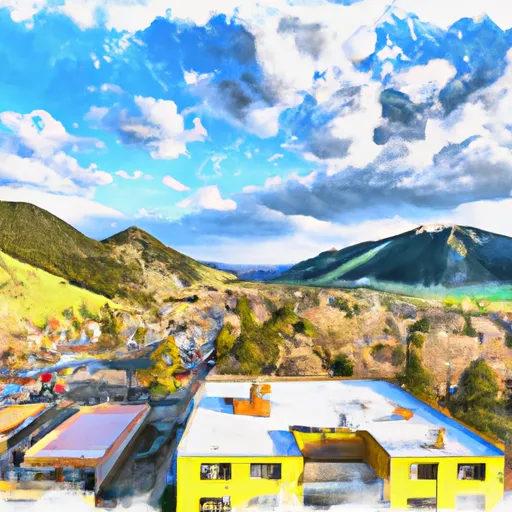-
 Snoflo Premium
Snoflo Premium
Get unlimited access to all our content
With no Ad interruptions! - Start Your Free Trial Login with existing account
Hot-Sulphur-Springs
Eden Index
Climate
5.8
•
Recreation
5.3
•
Community
•
Safeguard
4.2/10

Hot Sulphur Springs is a charming town located in Grand County, Colorado. Known for its natural hot springs, it offers a unique experience for visitors seeking relaxation and outdoor activities. The climate in Hot Sulphur Springs is characterized by cold winters and mild summers. Winter temperatures often drop below freezing, perfect for skiing and snowboarding enthusiasts who can take advantage of nearby ski resorts. Spring and fall bring moderate temperatures, while summers are pleasant with temperatures ranging from the 70s to low 80s°F.
The town's hydrology is dominated by the Sulphur River, which runs through Hot Sulphur Springs, providing ample opportunities for fishing and boating. The river is known for its abundance of trout, making it a popular spot for anglers. Additionally, the area is surrounded by countless lakes, perfect for water activities such as kayaking and paddleboarding.
Outdoor recreation opportunities in Hot Sulphur Springs are plentiful. Visitors can explore the nearby Arapaho National Forest, offering opportunities for hiking, camping, and wildlife viewing. There are also numerous trails for mountain biking and horseback riding, allowing visitors to immerse themselves in the breathtaking natural beauty of the area. Overall, Hot Sulphur Springs is a haven for outdoor enthusiasts, offering a diverse range of activities to suit all interests.
What is the Eden Index?
The Snoflo Eden Index serves as a comprehensive rating system for regions, evaluating their desirability through a holistic assessment of climate health, outdoor recreation opportunities, and natural disaster risk, acknowledging the profound impact of these factors on livability and well-being.
Climate Health Indicator (CHI): 5.8
Hot-Sulphur-Springs receives approximately
426mm of rain per year,
with humidity levels near 68%
and air temperatures averaging around
3°C.
Hot-Sulphur-Springs has a plant hardyness factor of
4, meaning
plants and agriculture in this region thrive during a short period during spring and early summer. Most
plants will die off during the colder winter months.
By considering the ideal temperature range, reliable water supplies, clean air, and stable seasonal rain or snowpacks, the Climate Health Indicator (CHI) underscores the significance of a healthy climate as the foundation for quality living.
A healthy climate is paramount for ensuring a high quality of life and livability in a region, fostering both physical well-being and environmental harmony. This can be characterized by ideal temperatures, reliable access to water supplies, clean air, and consistent seasonal rain or snowpacks.
Weather Forecast
Streamflow Conditions
Colorado Headwaters
Area Rivers
Colorado Headwaters
Snowpack Depths
Colorado Headwaters
Reservoir Storage Capacity
Colorado Headwaters
Groundwater Levels
Recreational Opportunity Index (ROI): 5.3
The Recreational Opportunity Index (ROI) recognizes the value of outdoor recreational options, such as parks, hiking trails, camping sites, and fishing spots, while acknowledging that climate plays a pivotal role in ensuring the comfort and consistency of these experiences.
Access to outdoor recreational opportunities, encompassing activities such as parks, hiking, camping, and fishing, is crucial for overall well-being, and the climate plays a pivotal role in enabling and enhancing these experiences, ensuring that individuals can engage in nature-based activities comfortably and consistently.
Camping Areas
| Campground | Campsites | Reservations | Toilets | Showers | Elevation |
|---|---|---|---|---|---|
| Gore Creek | 25 | 8,720 ft | |||
| Heaton Bay | 81 | 9,072 ft | |||
| Lowry | 24 | 9,068 ft | |||
| Prospector | 107 | 9,105 ft | |||
| Pine Cove | 56 | 9,022 ft | |||
| Selkirk | 15 | 10,488 ft | |||
| Blue River | 24 | 8,472 ft | |||
| Kite Lake | 5 | 12,043 ft | |||
| Peak One | 74 | 9,030 ft | |||
| Camp Hale Memorial | 21 | 9,318 ft |
Nearby Ski Areas
Catastrophe Safeguard Index (CSI):
The Catastrophe Safeguard Index (CSI) recognizes that natural disaster risk, encompassing floods, fires, hurricanes, and tornadoes, can drastically affect safety and the overall appeal of an area.
The level of natural disaster risk in a region significantly affects safety and the overall livability, with climate change amplifying these risks by potentially increasing the frequency and intensity of events like floods, fires, hurricanes, and tornadoes, thereby posing substantial challenges to community resilience and well-being.
Community Resilience Indicator (CRI):
The Community Resilience Indicator (CRI) recognizes that education, healthcare, and socioeconomics are crucial to the well-being of a region. The CRI acknowledges the profound impact of these elements on residents' overall quality of life. By evaluating educational resources, healthcare accessibility, and economic inclusivity, the index captures the essential aspects that contribute to a thriving community, fostering resident satisfaction, equity, and social cohesion.

